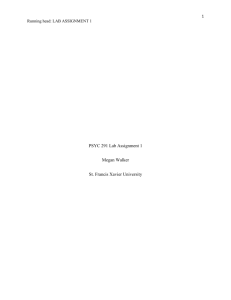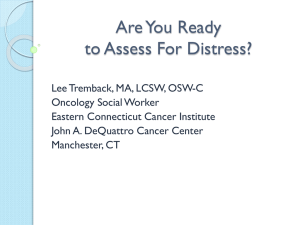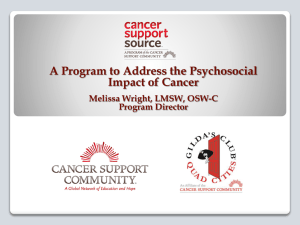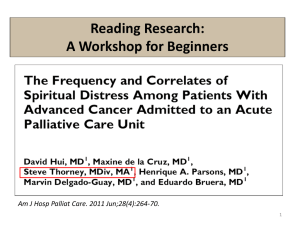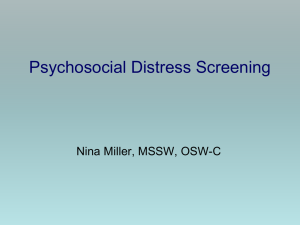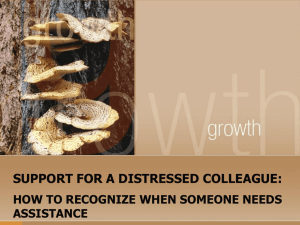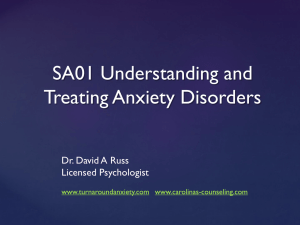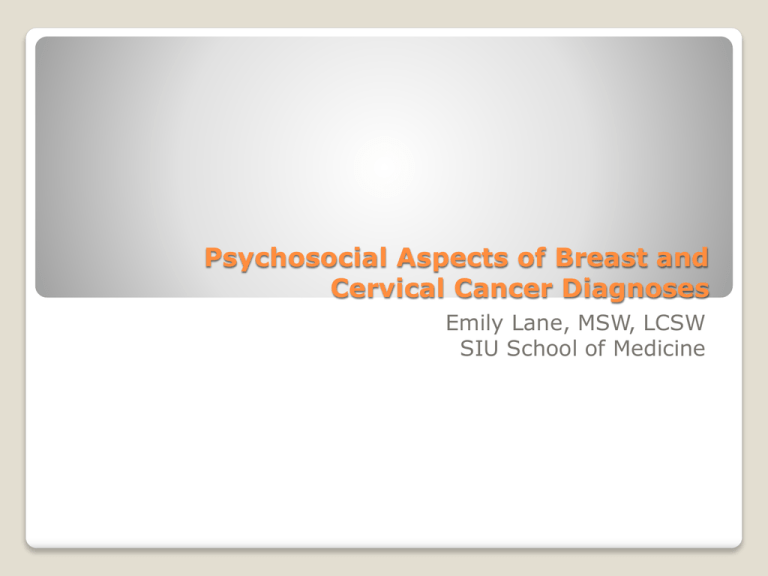
Psychosocial Aspects of Breast and
Cervical Cancer Diagnoses
Emily Lane, MSW, LCSW
SIU School of Medicine
A little about me…
At the end of this webinar, you should be able to…
◦ Identify possible psychosocial stressors associated with
breast and cervical cancer diagnoses.
◦ Recognize symptoms of psychological distress in newly
diagnosed patients.
◦ Utilize supportive interventions with the hopes of decreasing
the level of acute distress in patients with breast or cervical
cancers.
◦ Educate patients on avenues of assistance and coordinate
appropriate referrals to alleviate some of the psychosocial
distress that they are experiencing.
Objectives
What are psychosocial stressors?
◦ Social conditions that can affect our mental health.
◦ Example: financial concerns can lead to feelings of
inadequacy or depression OR major depression could
lead to missed days of work and subsequent financial
concerns
Common psychosocial stressors
for persons with cancer
Financial
Physical
Interpersonal
Psychological Distress
Financial
◦ Unable to work due to appointments or treatment
◦ Uninsured/underinsured
◦ Out-of-pocket costs for medications
Physical
◦ Side-effects from chemotherapy, surgery, radiation
and/or hormone treatments
◦ Difficulty with activities of daily living
◦ Transportation
◦ Navigation of the healthcare system
Interpersonal
◦ Difficulty communicating with loved ones because of high
levels of distress
◦ Little support from family and friends
◦ Too many people counting on the person with cancer
◦ Changes in libido and sexuality can lead to difficulties in
marriage
Significant pain from internal radiation which can lead to
difficulty having sex afterward. This can lead to marital
strain.
Guilt/Shame of HPV infection or stigma
Fertility concerns – early menopause
Cervical cancer is 10x more prevalent in women who are
victims of domestic violence than in general population
Cervical Cancer Specific
Body image issues may result from physical changes to the
breast from surgery, radiation
Femininity/Sexuality issues can lead to marital strain
Lymphedema – can be a financial burden due to the
supplies needed to manage the condition
Breast Cancer Specific
◦
◦
◦
◦
◦
◦
◦
◦
Depression
Anxiety
Anger
Guilt
Difficulty sleeping
Existential questions
Difficulty concentrating
Distress over treatment choices
The emotional toll of these stressors
What is psychological distress?
The National Cancer Institute defines
psychological distress as “an unpleasant
experience of an emotional, psychological, social,
or spiritual nature that interferes with the ability
to cope with cancer treatment. It extends along
a continuum, from common normal feelings of
vulnerability, sadness, and fears, to problems
that are disabling, such as true depression,
anxiety, panic, and feeling isolated or in a
spiritual crisis”
Use of a distress
screener can help
you find out what
your patients are
dealing with both
physically and
emotionally.
http://www.nccn.org/patients/resources/life_with_cancer/pdf/nccn_distress_thermometer.pdf
We know the problem
How do we help?
Validation and Communication
Empathic Statements
◦ Reflection
◦ Statements of understanding
◦ Ask patients how they feel
Mirroring
Active Listening
Being able to just sit with a patient and their
emotions
Normalizing emotions
Validation
Building block of rapport
◦ Adds to patient’s subjective experience of a safe
place to express him or herself
Facilitates hope
Improves patient compliance and satisfaction
Why is empathy important?
Provide education as to what the next step is
regarding treatment and/or follow-up.
Ask patients if it would help them if you made the
follow-up appointments for them.
Ask them if they have any immediate concerns, such
as support at home, transportation, insurance
coverage and/or other financial issues.
Provide information regarding resources in the
community.
Communication
A word about survivorship…
Illinois Breast and Cervical Cancer Program
American Cancer Society
◦ Patient navigators to assist with financial concerns and
other needs
◦ Wig Salon
◦ Look Good, Feel Better
◦ Road to Recovery
◦ Co-Pay Assistance
Community Action Agencies
◦ Sangamon County Resource Center
Local Support Groups
Resources
www.needymeds.com
www.getcoveredillinois.gov
www.cancer.org
www.nccn.org/patients/resources/life_with_cancer/
www.livestrong.org
www.cancercare.org
Helpful websites
Final Thoughts
Each person is unique, and their response to a
cancer diagnosis will be just as unique.
Ask your patients about how they are coping,
what they are feeling and what they need… don’t
assume to know.
Encourage them to share their feelings with their
loved ones or with a oncology social worker,
counselor or psychologist.
References
American Cancer Society. (2013). What is Breast Cancer? Retrieved from:
http://www.cancer.org/acs/groups/cid/documents/webcontent/003090-pdf.pdf.
Arm, J., Crowe, L.C., Morgan, H., Murrells, T., Oakley, C., Palmer, N., Ream, E.,
Young, A., &Richardson, A. (2009). Patients’ supportive care needs
beyond the end of cancer treatment: A prospective, longitudinal study.
Journal of Clinical Oncology, 27(36): 6172-6179.
◦
Brintzenhofe-Szoc, K.M., Levin, T.T., Li,Y., Kissane, D.W., & Zabora, J.R.
(2009). Mixed anxiety/depression symptoms in a large cancer cohort:
prevalence by cancer type. Psychosomatics, 50:383–391.
Camu, J.N. (2013). Mirroring: A calculated therapeutic technique or just
conversation? Understanding how and why a shiny reflective
surface might heal. Retrieved November 25, 2013
from www.fuelforemtionalhealth.com.
Carpenter, K.M., Fowler, J.M., Maxwell, G.L., & Anderson, B.L. (2010). Direct
and buffering effects of social support among gynecologic cancer
survivors. Annuls of Behavioral Medicine, 39: 79-90.
Cesario, S.K., McFarlane, J., Angeles, N., Gilroy, H., & Maddoux, J. (2014).
Linking cancer and intimate partner violence. Clinical Journal of Oncology
Nursing, 18(1): 65-79.
◦
◦
Drolet, M., Brisson, M., Maunsell, E., Franco, E., Coutlee, F., Ferenczy, A., Fisher,
W., & Mansi, J. (2012). The psychosocial impact of an abnormal cervical
smear result. Psycho-Oncology, 21:1071-1081.
Eskelinen, M. & Ollonen, P. (2011). Assessment of general anxiety in
patients with breast disease and breast cancer using the Spielberger STAI
self evaluation test: a prospective case–control study in Finland. Anticancer
Research, 31:1801–1806.
Fobair, P., Stweart, S. L., Chang, S., D’Onofrio, C., Banks, P.J., & Bloom, J.R. (2006).
Body image and sexual problems in young women with breast cancer.
Psychooncology, 15 (7): 579-94.
Gerdes, K. E., Segal, E. A., (2009). A social work model of empathy. Advances in
Social Work, 10(2), 114-127
Institute of Medicine. (2007). Cancer care for the whole patient: Meeting
psychosocial health needs. Washington, DC: The National Academies Press.
Meyer, T.J. & Mark, M.M. (1995). Effects of psychosocial interventions with adult
cancer patients: a meta-analysis of randomized experiments. Health
Psychology, 14:101-8.
Neukrug, E., Bayne, H., Dean-Nganga, L., Pusateri, C. (2013). Creative and novel
approaches to empathy: A neo-Rogerian perspective. Journal of Mental
Health Counseling, 35(1), 29-42.
Ollonen, P., Lehtonen, J., & Eskelinen, M. (2005). Anxiety, depression, and the
history of psychiatric symptoms in patients with breast disease: a prospective
case–control study in Kuopio, Finland. Anticancer Research, 25:2527–2533.
Rashid, A. (2011). Anxiety in Cancer Patients. In Duffy, J.D. & Valentine, A.D.(Eds.),
MD Anderson manual of psychosocial oncology (pp. 271-288). New York:
McGraw-Hill Companies, Inc.
Reiss, H., Kelley, J. M., Bailey, R. W., Dunn, E. J., Phillips, M. (2012). Empathy
training for resident physicians: A randomized controlled trial of a
neuroscience-informed curriculum. Journal of General Internal Medicine,
27(10), 1280-1286.
Spandler, H., Stickley, T. (2011). No hope without compassion: the importance of
compassion in recover-focused mental health services. Journal of Mental
Health, 20(6), 555-566.
Valentine, A.D. (2011). Mood Disorders. In Duffy, J.D. & Valentine, A.D. (Eds.), MD
Anderson manual of psychosocial oncology (pp. 271-288). New York:
McGraw-Hill Companies, Inc.
Special thanks to Katherine Howerter, MSW, LCSW
and Patricia Fank, Psy.D. for their contributions and
guidance.

